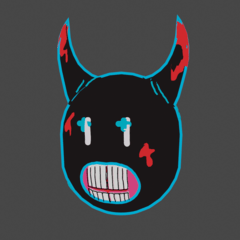How To: CRUSTACEANS
There are over 70, 000 types of crustaceans, each more fascinating than the next!
Still, they share a few things in common that makes them both easily recognizable and pleasant to draw.
In this tutorial we're gonna take a look at 2 distinct creatures and their characteristics
1. GIANT ISOPODES
These creepy parasites attach themselves to other creatures and slowly eat them away. They're still interesting to learn about though. The largest ones reach 50 cm in length and can live a ve-e-ery long life.
Due to the clear logic of their anatomy we're going to take a look at them and try and break down the main things that make them recognizable.
I've covered the main things in the illustration itself but I will add an additional summary:
- think of them as one of those jointed toys where there is a single point of attachment and everything moves around it
- similar to their land cousins "the woodlouse" they are also able to roll into a perfect ball
- their appendages are specifically oriented this way so they can not only scuttle faster around their environment but also neatly tuck them into their abdomen
Their usual colouring ranges from bluish gray to pale lilac (they're starting to look kinda cute).
Here I'm showing a CSP function I came across recently and that is Colorize! I absolutely love it.
The way it works is that you'll be working with two layers - the lineart will be set as a refence layer and beneath you will have the layer where you will put the color guides>>>
I use the second function.
Here is the result:
And the way I decided to build on top of it:
For such creepy crawlies they can sure turn out cute!
Hope this has been useful to someone :) Only thing you need really is to give yourself some time to just look at the subject you wish to draw. No matter how weird it looks it always has a logic to its shape. Organic or non-organic shapes are shapes and they can always be broken down and studied.
The only thing I personally don't do and recommend is reducing complex objects to extremely basic shapes. You can get overwhelmed trying to build on top of it. I try to catch the movement first and then start to add simple guides to the details!
2. BARNACLES
Again there are a lot of barnacle species (around 1000) but they also have extremely recognizable characteristics that once you get the hang of you can use and change and create barnacles and vaguely looking barnacle creatures.
----------Here I will take a lyrical break and mention the book "Imaginative Realism: How to paint what doesn't exist" by James Gurney. It's worth acquiring it and reading it.
The main takeaway form there is that no matter how phantasmagorical a creature/building/civilization is, it must have some kind of logic and reason to the way it looks and function.
Speculative evolution is also an extremely interesting topic to explore. ------------
Back to the barnacles.
Most of my tips are in the illustration itself, but it's important to note that you should give yourself freedom when drawing them because all they are is rounded blobs of calcified shells with holes.
To create the coloured version of the barnacles I used the standard CSP watercolour brushes - Wet Wash is my favourite. For heavier colouring I use the Thin Gouache Brush.
You'll notice that the shadows are clearly defined and the direction of the light source is coming from the top.
Also, in this example I only painted one barnacle and copied and deformed it for the other four. I used the basic transform tools.
I'd recommend if you're used to working in a larger scale to start by laying down a flat colour in a vague shape of a barnacle cluster and start building up detail from there!
Good luck! Don't be afraid of the barnacles even though they're covered in holes. Somehow they've taught themselves to eat microplastics.

















Comment